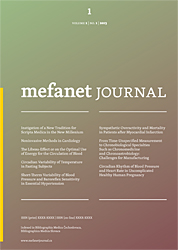
MEFANET Journal 2014; 2(1): 4
EDITORIAL MATERIAL
Preface
Daniel Schwarz
Institute of Biostatistics and Analyses, Faculty of Medicine at Masaryk University, Czech Republic
schwarz@iba.muni.cz
Let me welcome readers of the second volume of the “MEFANET Journal (Mefanet J)”, which was launched in June 2013, and thank all those readers who sent us comments on the first volume comprising two maiden issues (June 2013, December 2013). This journal has been envisioned and founded to represent the growing needs of computational science as an emerging and increasingly vital field, now widely recognized as an integral part of scientific and technical investigations in medical education. Now we are about to ramp up the publication of the second volume, which will again comprise two issues, consisting of around eight original articles - complemented by useful tutorials and editorials. A stream of quality manuscripts has been quite steadily arriving at the publisher's online peer-review system (Open Journal System), enabling regular biannual publication of the journal.
This editorial touches on three original articles, one reviewed tutorial and another editorial material published in the current issue. The reviewed tutorial by M. Švída & J. Majerník deals with tools and techniques used to manage secured data access on external data storage devices. Hospital information systems address the data security and protection at least at the level of authorized users, but many problems will arise if external sources of data are used, e.g., in educational or research activities. This tutorial aims to increase the awareness in this area and comes up with an introduction to well-proven ICT tools, such as TrueCrypt or KeePass. The original research article by M. Mateják explores physiology programming with Modelica. The author discusses the use of various solvers and toolboxes for Modelica, such as Dymola, OpenModelica or JModelica and presents Physiolibrary (www.physiolibrary.org) – a free, open-source Modelica library for human physiology, including explicit examples and the source code – attached as a supplementary material to the electronic version of the paper. P. Měřička et al. present the design and experience from a pilot implementation of an e-learning course focused on tissue banking. The authors highlight the differences in the methods of assessment when studying the e-learning version compared to the classical version of their optional course. The qualitative structured study by N. Beckett et al. touches upon students’ attitudes to Objective Structured Clinical Examinations (OSCEs) designed to assess specific competencies using standardized peer-reviewed checklists. The final editorial material by J. Gregor et al. recall the most important memories from the last 7th year of the MEFANET conference, which took place in Brno at the end of November 2013. The MEFANET conferences have always been providing an exciting meeting place for delegates from medical and healthcare faculties, computer scientists as well as medical teachers and students from the Czech Republic, Slovakia and other countries. In 2014, the upcoming 8th year of the MEFANET conference (26th to 27th November 2014 – Brno, Czech Republic) will be focused on technology-enhanced learning and teaching in acute medicine.
This issue would not have been possible without the great support of the Editorial Board members and reviewers – I would like to express my sincere thanks to all of them. I hope that the whole second volume of the MEFANET Journal will be another valuable resource for the MEFANET community and will stimulate further research into the vibrant area of medical education science. The wide range of topics presented in this issue emphasizes the complexity of the ICT use in medical education. Readers are encouraged to submit both comments on these and other published articles as well as their own relevant manuscripts.
June 2014

Daniel Schwarz
Editor-in-chief
Supplementary material










